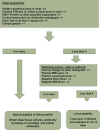Diagnosing diabetic foot osteomyelitis: narrative review and a suggested 2-step score-based diagnostic pathway for clinicians
- PMID: 25734130
- PMCID: PMC4281812
- DOI: 10.1093/ofid/ofu060
Diagnosing diabetic foot osteomyelitis: narrative review and a suggested 2-step score-based diagnostic pathway for clinicians
Abstract
The diabetic foot infection remains a major cause of morbidity and mortality in many patients and remains a challenging diagnosis for most clinicians. Diagnosis is largely based on clinical signs supplemented by various imaging tests. Magnetic resonance imaging (MRI) is not readily available to many clinicians, and bone biopsy, which is the accepted criterion standard for diagnosis, is rarely performed routinely. This evidence-based review and the proposed diagnostic scoring pathway substratifies the current International Working Group on the Diabetes Foot guidelines for diagnosing diabetic foot osteomyelitis into a convenient 2-step diagnostic pathway for clinicians. This proposed diagnostic approach will need further validation prospectively, but it can serve as a useful diagnostic tool during the initial assessment and management of diabetic foot infections. A MEDLINE search of English-language articles on diabetic foot osteomyelitis published between 1986 and March 2014 was conducted. Additional articles were also identified through a search of references from the retrieved articles, published guidelines, systematic reviews, and meta-analyses.
Keywords: diabetes; diabetic foot; diagnosis; infection; osteomyelitis; systematic review.
Figures
References
-
- Wild S, Roglic G, Green A, et al. Global prevalence of diabetes: estimates for the year 2000 and projections for 2030. Diabetes Care. 2004;27:1047–53. - PubMed
-
- Armstrong DG, Wrobel J, Robbins JM. Guest editorial: are diabetes-related wounds and amputations worse than cancer? Int Wound J. 2007;4:286–7. - PubMed
-
- Berendt AR, Peters EJ, Bakker K, et al. Diabetic foot osteomyelitis: a progress report on diagnosis and a systematic review of treatment. Diabetes Metab Res Rev. 2008;24(Suppl 1):S145–61. - PubMed
-
- Berendt AR, Lipsky B. Is this bone infected or not? Differentiating neuro-osteoarthropathy from osteomyelitis in the diabetic foot. Curr Diab Rep. 2004;4:424–9. - PubMed
Publication types
LinkOut - more resources
Full Text Sources
Other Literature Sources


